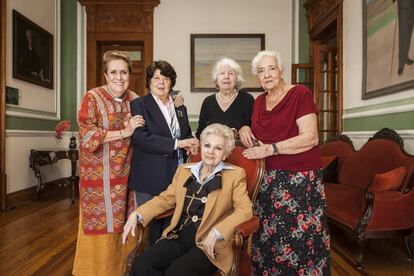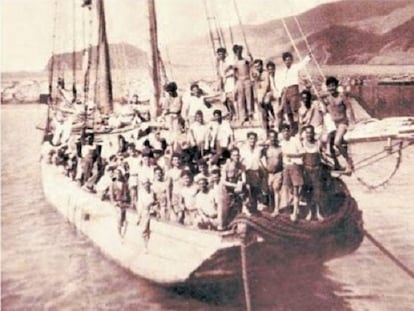Spanish exiles in Mexico: a story of gratitude
Women who arrived in North American country with families to escape Civil War recount experience

Mexico gave them a new opportunity, and they wanted to give Mexico something back. It happened over 70 years ago, but they still remember it as though it were only yesterday. They are part of a generation of Spanish Republican exiles who were fleeing the Spanish Civil War (1936-1939) and the regime of the dictator Francisco Franco. They were also trying to get away from poor conditions for Spanish exiles in France. In a Mexico then under the administration of L¨¢zaro C¨¢rdenas, who governed from 1934 to 1940, they were welcomed with open arms.

The governments of the Mexican and Spanish Republics had laid out the groundwork for the arrival of a large number of Spaniards whose ship, the Sinaia, drew into the port of Veracruz on June 13, 1939. Five women who were part of that group, and who are now Mexican citizens, recently shared their experiences and expressed renewed gratitude for the land that took them in and gave them a new lease on life.
Teresa Mart¨ªn, a painter who was born in Madrid in 1936, remembers that no one talked about the Spanish Republic at her house. The family had been divided, with members taking different sides during the war, and her father had been a prisoner at a French concentration camp.
But the family did sing. During gatherings of Spanish Republicans, a young Mart¨ªn would be asked to sing ¡°Francisco alegre, or La bien pag¨¢... songs that allowed these men to remember, and they cried when they heard them,¡± she remembers.
Mexico is not welcoming Central Americans the way it welcomed the Spanish
Carmen Tag¨¹e?a, Spanish Ateneo in Mexico
Sinaia, Mexique, Ipanema, Orinoco, Flandre or Nyassa are names that represented salvation for many of them. They were the names of the ships commissioned until 1942 to take around 25,000 Spaniards to Mexico, then a country with a population of fewer than 20 million people.
¡°We arrived at Veracruz and were received by women in traditional dress. We were taken to a hotel, fed, and the next day they gave us a bus ticket to the capital,¡± recalls Trinidad Mart¨ªnez, who was born in Barcelona in 1928. Mart¨ªnez grew up to be an economist who founded the Centro de Investigaci¨®n y de Docencia Econ¨®mica (CIDE), a highly reputed research institute.
Their personal experiences contrast with today¡¯s world, where solidarity with Syrian refugees is wavering and national borders are being reinforced.
Mexico never did recognize the legitimacy of the Franco regime. It was only after Adolfo Su¨¢rez became the first democratically elected prime minister after Franco in 1976 that diplomatic relations were renewed. This week marks the 40th anniversary of that thaw.

¡°My father always used to say to my sister and I, ¡®Mexico has given us everything and never asked us for anything in return. Whenever you can, give something back¡¯,¡± recalls an emotional Mart¨ªnez.
¡°My parents also taught me to be grateful,¡± agrees Mart¨ªn. For years, she taught workshops at public libraries across the city to encourage children to read.
¡°That job of teaching children and teenagers was my way of thanking Mexico,¡± explains the artist.
Meanwhile, the economist Mart¨ªnez worked in Scotland for 11 years, then realized that it was necessary to develop the field of postgraduate studies in Mexico¡¯s educational sector. That was the seed of CIDE. ¡°I told myself that I had to go back and reinforce that.¡±
Mexico never did recognize the legitimacy of the Franco regime
Loty de la Granja, Paloma Altolaguirre, Teresa Mart¨ªn and the recently deceased poet Carmen Romero de Rayo have all known each other since they were kids, and have shared the same friends. They are living reminders of a chapter in recent Spanish history that has been forgotten: the first generation of Spanish women who had a chance to study. Many of them did, and went on to become doctors, lawyers, fashion designers and factory managers.
A project for Mexico
Carmen Tag¨¹e?a, president of the Spanish Ateneo in Mexico, is herself the daughter of exiled Republicans. She organized the gathering that brought together all these women at this cultural center in the capital.
¡°The decision to take in Spanish Republican exiles was C¨¢rdenas¡¯ project for Mexico, because he believed that they had a lot to contribute to the country,¡± she notes. ¡°A lot of university schools had just been created, and there were a lot of teaching positions to fill. He also embarked on an agricultural project with the Spaniards. The people who came were trained in construction, baking... There was a range.¡±
After a pause, Tag¨¹e?a reflects that ¡°Mexico is not welcoming Central Americans the way it welcomed the Spanish.¡±
Trinidad Mart¨ªnez recalls escaping through the mountains of the Pyrenees in 1939, during one of the harshest winters in many years. She and Paloma Altolaguirre were little girls when it happened, and their personal memories have been complemented with research work. But there is something that none of them need to research because they know it for a fact: Mexico is their home now.
English version by Susana Urra.
Tu suscripci¨®n se est¨¢ usando en otro dispositivo
?Quieres a?adir otro usuario a tu suscripci¨®n?
Si contin¨²as leyendo en este dispositivo, no se podr¨¢ leer en el otro.
FlechaTu suscripci¨®n se est¨¢ usando en otro dispositivo y solo puedes acceder a EL PA?S desde un dispositivo a la vez.
Si quieres compartir tu cuenta, cambia tu suscripci¨®n a la modalidad Premium, as¨ª podr¨¢s a?adir otro usuario. Cada uno acceder¨¢ con su propia cuenta de email, lo que os permitir¨¢ personalizar vuestra experiencia en EL PA?S.
?Tienes una suscripci¨®n de empresa? Accede aqu¨ª para contratar m¨¢s cuentas.
En el caso de no saber qui¨¦n est¨¢ usando tu cuenta, te recomendamos cambiar tu contrase?a aqu¨ª.
Si decides continuar compartiendo tu cuenta, este mensaje se mostrar¨¢ en tu dispositivo y en el de la otra persona que est¨¢ usando tu cuenta de forma indefinida, afectando a tu experiencia de lectura. Puedes consultar aqu¨ª los t¨¦rminos y condiciones de la suscripci¨®n digital.










































